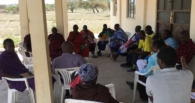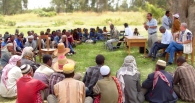The World Bank 17th Land and Poverty Conference
Reflections and reactions
Christopher Tanner
19 March 2016
/
- 0 Comments
Introduction
Mokoro was again present at what is now the ‘essential’ annual event in the land and natural resources calendar, the World Bank Land and Poverty Conference. This year was the 17th conference, and with over 1400 participants meeting over an entire week it has grown considerably in size and significance since it began as a small gathering of land specialists.
The scale and range of this year’s event underlines the way in which land has come back into centre stage on the development agenda. This year land and urban development figured prominently in the programme, marking the fact that for the first time the majority of people on the planet live in urban areas. Land has also been explicitly included in the new Sustainable Development Goals, and many papers focused on the significance of this and on how to develop the most appropriate indicators and targets for measuring success in achieving a world where secure and equitable land tenure and use rights will underpin the livelihoods of rural and urban populations alike.
This year’s conference also took place four years after the Voluntary Guidelines on the Responsible Governance of Tenure of Land, Fisheries and Forests in the Context of National Food Security (VGGT) were approved by the Committee on Food Security at FAO in Rome. Enough time has passed to begin talking about the effect and possible impact of the VGGT, and the way in which this kind of globally endorsed instrument can bring about real improvements in land governance and in the lives of those who depend on land in some way for their survival and personal growth.
The Conference was also notable for the strong presence of civil society organisations, and in particular of those working on gender and women’s rights issues. An active Women’s Caucus drove the discussion of women and land, with impressive examples of activism and courage around the world underlining how women – more than 50 percent of the global population – are central players in all aspects of development and the key to achieving the SDGs.
The sheer scale of the Conference is at times overpowering. One is confronted with a programme (see https://www.worldbank.org/en/events/2015/07/20/land-and-poverty-conference-2016-scaling-up-responsible-land-governance) that at any one time is running ten separate themed sessions, each including an average of 4-5 papers. With five sessions a day, this adds up to hundreds of papers over the week, and reveals the challenge facing your average conference participant – how to choose which sessions to go to when there are often at least two or three papers of particular interest running at the same time.
Conference takeaways
I was able to attend about 12 sessions overall, with between 50 and 60 papers. These ranged from discussions of new approaches to land policy in Africa, through community land rights delimitation and its impact, VGGT implementation, how to enhance women’s land rights, urban land issues, green growth, and the continuing challenge of reconciling commercial agriculture with the rights and needs of local land users. It would be impossible in a short article to summarise even the relatively few sessions I attended in person and rather than attempt that I have sketched out some of the main points and common threads that struck me as important ‘takeaways’ from this remarkable event.
The first takeaway was that VGGT implementation globally is going well. FAO and its bilateral partners are quietly and steadily creating a global awareness amongst governments and other stakeholders of the need for a more inclusive and participatory form of land governance as a cornerstone of equitable and sustainable development for all. Even the most reluctant governments now seem prepared to consider the VGGT and similar instruments like the Principles for Responsible Agricultural Investment (RAI) as a reference point as they move to improve existing or develop new land-related interventions.
However, seen together with other more focused sessions – especially on women’s rights – the second key takeaway is that, in spite of having ‘beautiful laws and principles’ in national frameworks (to quote one participant), in reality these are still not being implemented in practice. This is underlined by the fact that most countries already have clear statements about gender equality in their Constitutions, and even in regulating legislation, but nothing changes on the ground; thus we need to develop indicators for implementation and impact as well. Indeed, in one way or another, all the sessions I attended underlined the scale of the challenge still facing those who are fighting for a just and equitable form of land governance as the platform upon which a wide range of development initiatives are then constructed. One suggestion that appears to be gaining ground is a kind of ‘Doing Business’ (the World Bank’s annual report on how easy it is to invest and do business in different countries) for land.
Nevertheless, the VGGT are creating a solid platform from which the many groups working at grassroots level are able to gain traction and reinforce their arguments for change. Women’s rights are a good example, and this leads into the ‘third takeaway’, the mainstreaming of ‘women in development’. This was clearly illustrated at this Conference by the contributions from a wide range of individuals and organisations, and summed up by the forceful presence of members of the Huairou Commission (HC), established in 1995 at the 4th World Conference on Women in Beijing.
The Huairou Commission is one of several global manifestations of the way in which ‘the women’s movement’ has moved from being a kind of special issue lobby and right into the heart of the development debate. Women are of course an integral part of what any society is and does, and are central to the achievement of all development goals, not just those that are gender-specific. In truth we should not need special projects for women – like men they should be equal participants in and beneficiaries of any development intervention, as it is identified, designed and implemented. But reality demands that women themselves take up the struggle for change and equality, as central figures on the development agenda and not just as a ‘vulnerable group’ needing special attention. So at the other end of the scale from the HC, other papers by leaders of grassroots women’s movements in poor slum areas also underlined the growing power of informed and empowered women to transform the way in which entrenched problems of poverty and exclusion are being dealt with. They all left the Conference with an open challenge to respond to and integrate this issue into future programmes and policies, in the aid agencies and in governments, everywhere.
With Huairou Commission’s commitment to ‘grounding the global women’s movement in grassroots community development issues and to ensuring that women are central in the human settlements field’ (https://huairou.org/about-huairou/missionanddescription/), the presence of the HC links in to the fourth takeaway, which is the fact that urban land issues and urban development are now finally on the core agenda of the international development community industry. The HC is playing a key role in the preparation and implementation of the upcoming Habitat III Conference, to be held in Quito in October this year.[1] Many sessions in the Conference focused on urban development issues, with tenure security over land and property at the forefront of discussion. In many cases the arguments were similar to those so long applied in rural areas: people with secure tenure over their housing and urban landscape are better able to invest their limited resources in improving where and how they live. The other side to this is the sheer scale of the infrastructure and investment challenge we are facing on a global level. By 2050 some 70 percent of the world’s population will be urban, implying an additional 2-2.5 billion people living in cities. One paper estimated the financing challenge to build decent infrastructure to accommodate everyone at around US$91 trillion, comparing this with current annual world GDP of US$75 trillion. New systems to capture the land values that are presently being captured by elites driving property development all over the world are urgently needed. The topical issues of affordable housing and essentially taxing the rich to provide for the poor are both parts of this emerging debate on land governance issues in the urban setting.
Other papers made it equally clear how land administrations serving elite interests distort and constrain the process of urbanisation that is taking place everywhere. The conversion of customary land title to statutory land title (often a feature of shifting the urban boundary out into rural areas) ‘is highly profitable’, to quote one presenter. In countries where urban professional elites serving political interests also gain from property price spirals and see urban land investment as the only real savings vehicle available to them, reforming land governance systems is especially difficult. The urgent need to address this issue and create equitable, sustainable and peaceful cities is underlined by the rapidly increasing urban population.
The fifth takeaway concerns the issue of identifying and registering community and collective land rights. The conference underlined how this issue has become mainstream in many countries around the world, as a basic building block of good land governance and a more inclusive and participatory form of development. Giving local communities a greater role in land management and land administration processes is gaining ground across the globe. The lesson from several African countries is, to quote one speaker from Mozambique, ‘delimitation first!’. In other words, working with local communities to prove and protect their land rights creates a forward-looking vision of their own development which can then feed into wider development planning processes and community-facilitated (and legitimised) titling programmes. It also develops a capacity at local level to engage with other economic actors who might want access to local land, fostering the often talked about ‘win-win’ scenario where both investors and local people gain from new small- and large-scale investment.
Set against this, however, is the heady optimism of those promoting new technologies such as drones for reducing ever further the ‘per title’ or ‘per Certificate’ cost of delimitation and titling programmes. Several speakers and participants spoke of the need to be careful with numbers-driven titling programmes, and to refocus on the quality of delimitation and land tenure regularization (LTR) work. A focus on new technical wizardry can also risk sidelining the less ‘sexy’ and time consuming task of participatory work at local level, which is an integral part of the best delimitation methodologies. Many papers have emphasised how this approach has important by-products in terms of community capacity building and the opportunity to introduce discussions of issues such as gender and women’s rights alongside land governance and titling activities.
The sixth takeaway follows on implicitly from many of the points above, and involves a famous ‘elephant in the room’. In one of the sessions I attended she (or he) was finally brought out of the corner and into the centre of discussion. This is of course the question of the political economy of interests and power relations that must be addressed if progress towards the SDGs and a more equitable and sustainable world is to be maintained and deepened. In a session on what Africa might learn from Eastern European countries and Asia, there was a stark contrast between pushing ahead with new land administration systems even where the legal frameworks may not be ideal, and having to deal with deeply entrenched political interests before any progress on land access and related equality issues can be expected. Thus countries in Eastern Europe and Central Asia show huge improvements in the time it takes to register property (a key indicator in the annual World Bank ‘Doing Business’ report) after massive investment in digitalisation and the titling of millions of small farmers benefitting from ex-state farm redistribution; in contrast, a paper on Kenya demonstrated what the late Professor Okoth Ogendo called the ‘tremendous discontinuity’ between establishment land administrations (often replicating the colonial role and function of securing land for national elites) and the rapid pace of social and demographic change that demands an entirely new and transparent approach to land governance. In the Kenya case it has taken serious political unrest to bring about change, but even then there are risks of elites and the professionals who serve them trying to roll back recent changes in the governance system.
All of these questions are set against the other great challenge of our times, the need to combat and limit climate change. Sessions on community tenure of forest resources underlined again the importance of local engagement and of good governance in combatting the pressures that lead to deforestation and the conversion of forests to other uses. An interesting series of papers assessed the impact of community or collective titling of rights over forest resources. Cost-benefit and other quantitative techniques demonstrated clear positive effects for local people benefitting from these programmes. This has important implications for linking forest conservation to enhanced incomes for local people, given that some 25 percent of developing country forests are community controlled.
Data is also still a perennial issue. Many presenters spoke of the lack of good data to support their work; others underlined the need for all countries to gather and make available more and higher quality data, both to facilitate monitoring and evaluation work and to enhance the transparency and legitimacy of land and tenure administration and management.
To sum up
The Conference ranged over a vast landscape of empirical data, project reports, and normative analyses. Once again the World Bank must be commended for creating a space for so much high quality research and analytical work to be available in a single forum and open to wide-ranging debate by all present.
It is a pity that private sector land users and especially the large corporations and others involved in large scale land acquisitions were once again not well represented. The interplay between these interests, often backed by governments, and the communities and other stakeholders who were the focus group for this ‘land and poverty’ conference, is a key aspect of the debate on contemporary land governance. An event like this offers private sector bosses and their financial backers a unique opportunity to hear what the others think, and to talk to a wide range of stakeholders in an open and neutral space, with professional mediators and moderators able to conduct a constructive exchange of views.
Nevertheless, this 17th Conference ended with a distinctly positive spirit and a sense of careful optimism. Of particular note was the presence of civil society organisations and especially the women’s caucus; the many papers presented underline how these groups have – with or without government support – driven the land agenda and the whole land governance debate forwards and achieved impressive results. The Conference ended with a call to all the mainstream development agencies and their government partners to take full heed of this development and integrate the lessons coming out of this event into new programmes and policies.
[1] United Nations Conference on Housing and Sustainable Urban Development, to be held in Quito, Ecuador, on 17-20 October 2016. See more at: http://citiscope.org/habitatIII/explainer/2015/06/what-habitat-iii
You must be logged in to post a comment.



